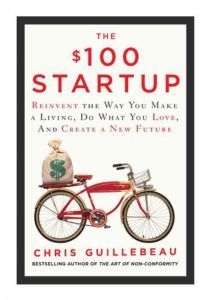So, you are interested in creating a $100 Startup Business? Doing a business that you love? Possibly a company you can run from anywhere? In that case, I have a recommendation for you. You need to read Chris Guillebeau’s book The $100 Startup:
In this post, I’m going to go through some of the most important topics, tell you why they work, and get you started on making your dream a reality.
Finding The Resources You Need for $100 Startup Business
Chris starts the book with a concept that I wholeheartedly believe in: You Already Have Everything You Need.
Or, in his words,
“You already have the sills you need–you just need to know where to look.”
Oftentimes, entrepreneurs are stuck with the idea of what to do, where to get started, and where to find the start-up cash they think is necessary to build their dream. However, I have found in my experience (and with working with my clients) …
You already have the skills you need. AND, you already have the resources you need to get started.
Chris shares numerous case studies of how regular people (with little-to-no business experience) were able to fund their startups for under $100. Given the fact that most people I know have a phone that costs more than that, I would venture to say that you can find a way to scrape together a hundred bucks.
What you need to do next is find a point of focus, and start putting your ideas into action. Gone are the days of writing an overly detailed business plan, getting funding, waiting for investors, and then getting started. The new way of doing business is to start it on the side, or start something small or manageable that you can run yourself.
The New Entrepreneur
Entrepreneurs are popping up all over the place, whether you see them or not. Some key terms brought up in this book that you should know about are:
Microbusiness – a mini-business that can be run by one person
Solopreneur – someone who is in business and going solo
The advantage of doing business this way is that you have the ability to increase your profits, and if run properly, lower your stress. Many ways of running your mini-biz are outlined in the book, including how to scale your business venture, create various income streams, and do so in a way that creates value and freedom. Consider this:
- You can run a business with little to no overhead.
- You don’t have to manage employees.
- The profit goes straight to your bottom-line, which means that it goes to you.
- Because your costs are low, you can pass the savings onto your customers / clients.
Know Your Skills
Understanding yourself is key to knowing what it is you want to share with the world. Take some time to brainstorm what your particular skill sets are. This could be a combination of your education or training, or, it could be attributes that you are naturally good at or drawn to. You will need to have a firm grasp of what drives you, what you are good at, and how you can help others.
(**not all of the startups mentioned in this book were based on this process, some companies were created by seeing an opportunity or gap in the market and going for it. Personally, I believe no matter what, you need to be passionate about what you do, and this is what will keep you going!)
Know Your Market
It is more-than-important that you understand what your market wants. As Chris explains, and what I’ve also experienced, is this can be an ongoing process. This may sound like a simple concept, but it is true: The more you work with your market, the better you will understand what they want.
You can sit around all day and theorize about it. But the best bet is to start something, and see what people buying. I go through a lot of tactics for this in my FREE Video Course, but mostly, it is a series of trial, error, measurement, and adaptation.
Understand Convergence
“The easiest way to understand convergence is to think of it as the overlapping space between what you care about and what other people are willing to spend money on.”
Great if you do what you love, but better if you can make money at it. Chris brings up an important fact in this section… What you think your audience wants may be different than what they actually want. Once you land on what they really want and can offer it to them in a way that converts, at a price they’ll buy, you are officially in business.
Pitch Products Your Clients Will Love
My favorite part of The $100 Startup was the detailed description of how to creatively pitch your products or ideas to future clients/ customers. Since you will need to effectively sell things to stay in business, I recommend reading, understanding, and implementing the chapters in Part 2, Taking it to The Streets.
It is far too much information to put in one blog pust, which is why you should get the book. Everything you need to launch is outlined for you, and done so in a way that your audience can get excited about your creations, and get ready to purchase. If you are not comfortable with the idea of self-promotion, or if the word ‘sales’ scares you, you will really benefit from this step-by-step guide for kickstarting your new career.
Buy The Book.
I’m not just saying this. I’m actually telling you to buy it. If you are at all interested in designing the life of your dreams, you will only get there by following the advice of people that have Already created success.
I have followed these tactics, and I have the pleasure of doing my business from a tropical beach in paradise.
This is also a great present to keep in mind for the Entrepreneur in your life. Great present for the holidays!
Here’s the link:


